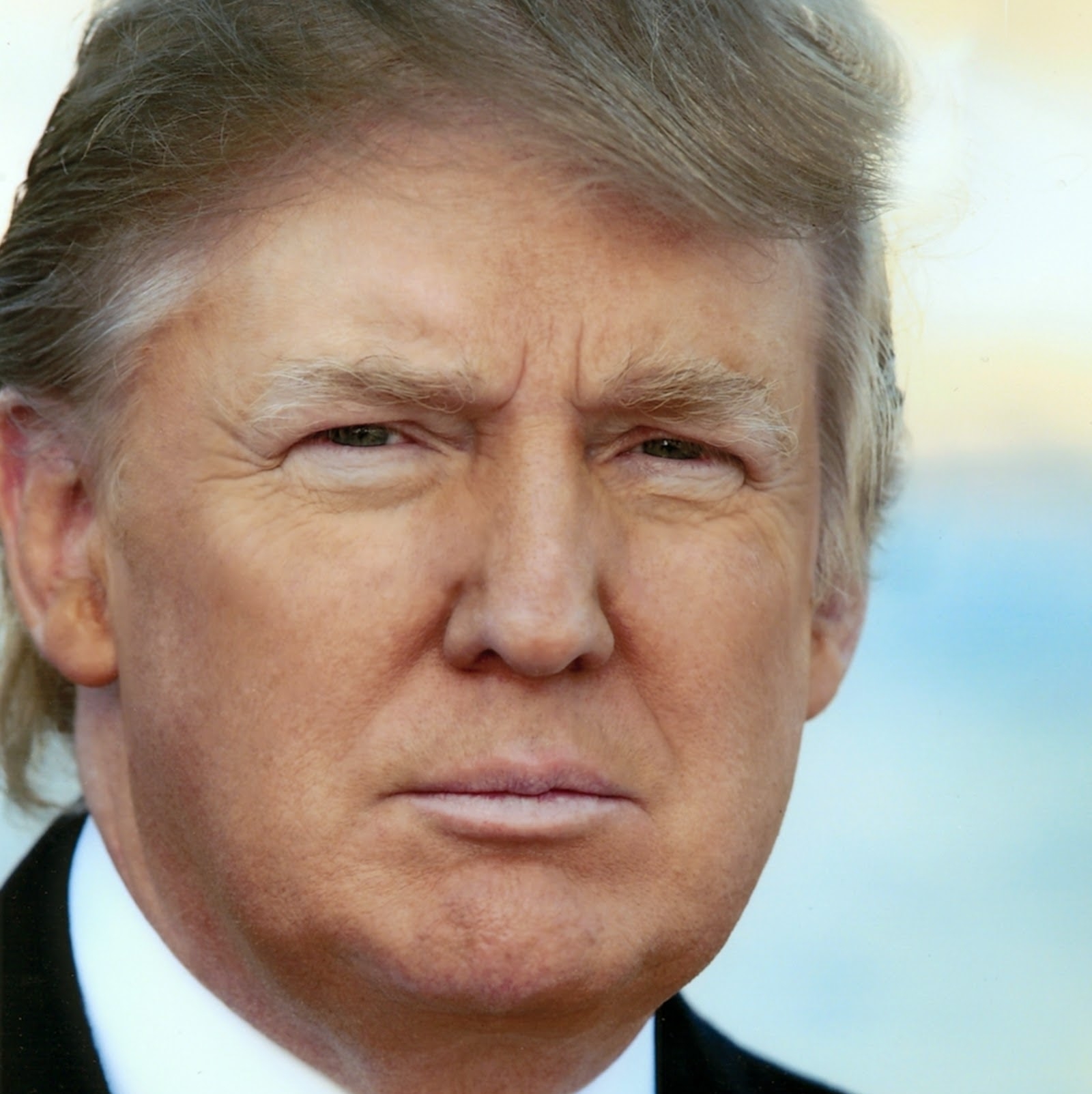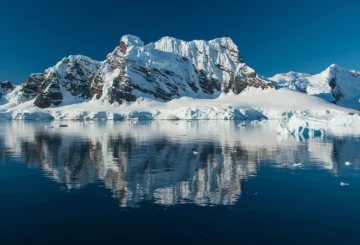Donald Trump
From Wikipedia, the free encyclopedia Jump to navigationJump to search For other uses, seeDonald Trump (disambiguation).
Trump entered the 2016 presidential race as a Republican and defeated sixteen opponents in the primaries. Commentators described his political positions as populist, protectionist, and nationalist. His campaign received extensive free media coverage; many of his public statements were controversial or false. Trump was elected president in a surprise victory over Democratic nominee Hillary Clinton. He became the oldest and wealthiest person ever to assume the presidency, the first without prior military or government service, and the fifth to have won the election while losing the popular vote. His election and policies have sparked numerous protests.
Trump was born and raised in the New York City borough of Queens, and received an economics degree from the Wharton School of the University of Pennsylvania. He took charge of his family’s real estate business in 1971, renamed it The Trump Organization, and expanded it into Manhattan. The company built or renovated several skyscrapers, hotels, casinos, and golf courses. Trump later started various side ventures, including licensing his name for real estate and consumer products. He managed the company until his 2017 inauguration. He co-authored several books, including The Art of the Deal. He owned the Miss Universe and Miss USA beauty pageants from 1996 to 2015, and he produced and hosted The Apprentice from 2003 to 2015. According to March 2018 estimates by Forbes, he is the world’s 766th richest person, with a net worth of US$3.1 billion.Donald John Trump (born June 14, 1946) is the 45th and current President of the United States, in office since January 20, 2017. Before entering politics, he was a businessman and television personality.
During his presidency, Trump ordered a travel ban on citizens from several Muslim-majority countries, citing security concerns; a revised version of the ban was implemented after legal challenges. He signed tax cut legislation, rescinded the individual insurance mandate provision of the Affordable Care Act, and opened the Arctic Refuge for oil drilling. He also enacted a partial repeal of the Dodd-Frank Act that had imposed stricter constraints on banks in the aftermath of the 2008 financial crisis. Trump pursued his America First agenda, highlighted by withdrawing the U.S. from the Trans-Pacific Partnership trade negotiations, the Paris Agreement on climate change, and the Iran nuclear deal. He imposed import tariffs on various goods from China, Canada, Mexico and the European Union.
After Trump dismissed FBI Director James Comey, the Justice Department appointed Robert Mueller as Special Counsel to investigate coordination or links between the Trump campaign and the Russian government in its election interference. Trump has repeatedly denied accusations of collusion and obstruction of justice, calling the investigation a politically motivated „witch hunt„.
Family and personal life
Ancestry and parents
Further information:Trump family
Trump’s ancestors originated from the German village of Kallstadt in the Palatinate on his father’s side, and from the Outer Hebrides in Scotland on his mother’s side. All of his grandparents and his mother were born in Europe.[1]
Trump’s paternal grandfather, Friedrich Trump, first immigrated to the United States in 1885 at the age of 16 and became a citizen in 1892. He amassed a fortune operating boom-town restaurants and boarding houses in the Seattle area and the Klondike region of Canada during its gold rush.[2] On a visit to Kallstadt, he met Elisabeth Christ and married her in 1902. The couple permanently settled in New York in 1905.[3] Frederick died from influenza during the 1918 pandemic.[4]
Trump’s father Fred was born in 1905 in The Bronx. Fred started working with his mother in real estate when he was 15, shortly after his father’s death. Their company, „E. Trump & Son“, founded in 1923,[5][nb 1] was primarily active in the New York boroughs of Queens and Brooklyn. Fred eventually built and sold thousands of houses, barracks, and apartments.[4][10] The company was later renamed The Trump Organization, after Donald Trump took charge in 1971.[11]
Trump’s mother Mary Anne was born in Tong, Lewis, Scotland. At age 18 in 1930, she immigrated to New York, where she worked as a maid.[12] Fred and Mary were married in 1936 and raised their family in Queens.[12][13]
Early life and education
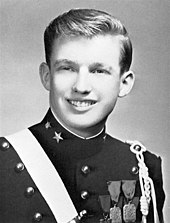 Senior yearbook photo of Trump in 1964 wearing the uniform of his private boarding school, New York Military Academy[14][15]
Senior yearbook photo of Trump in 1964 wearing the uniform of his private boarding school, New York Military Academy[14][15]
Donald John Trump was born on June 14, 1946, at the Jamaica Hospital Medical Center, Queens, New York City, the fourth of five children.[16] Trump grew up in Jamaica, Queens, and attended the Kew-Forest School from kindergarten through seventh grade. At age 13, he was enrolled in the New York Military Academy, a private boarding school, after his parents discovered that he had made frequent trips into Manhattan without their permission.[17][18]
In 1964, Trump enrolled at Fordham University.[14][19] After two years, he transferred to the Wharton School of the University of Pennsylvania.[19][20] While at Wharton, he worked at the family business, Elizabeth Trump & Son.[21] He graduated in May 1968 with a Bachelor of Science in economics.[19][22][23]
Trump did not serve in the military during the Vietnam War.[24] While in college from 1964 to 1968, he obtained four student deferments.[25] In 1966, he was deemed fit for service based upon a military medical examination and in July 1968, after graduating from college, was briefly classified as eligible to serve by a local draft board. In October 1968, he was classified as 1-Y, „unqualified for duty except in the case of a national emergency,“[26] and given a medical deferment which he later attributed to heel spurs; in 1972, the medical deferment was changed to 4-F, „not qualified for service.“[26][27][28] In the draft lottery in December 1969, Trump’s birthday, June 15, received a high number which would have given him a low probability to be called to military service even without the 1-Y medical deferment.[26][27][29]
Family
Main article:Family of Donald Trump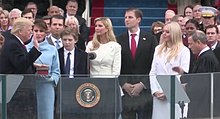 Donald Trump is sworn inas president on January 20, 2017. From left to right in foreground: Trump, wifeMelania, sonDonald Jr., sonBarron, daughterIvanka, sonEric, and daughterTiffany
Donald Trump is sworn inas president on January 20, 2017. From left to right in foreground: Trump, wifeMelania, sonDonald Jr., sonBarron, daughterIvanka, sonEric, and daughterTiffany
Trump grew up with three elder siblings—Maryanne, Fred Jr., and Elizabeth—as well as a younger brother named Robert. Maryanne is an inactive Federal Appeals Court judge on the Third Circuit.[30]
Trump has five children by three marriages, as well as nine grandchildren.[31][32] His first two marriages ended in widely publicized divorces.[33]
In 1977, Trump married Czech model Ivana Zelníčková at the Marble Collegiate Church in Manhattan, in a ceremony performed by the Reverend Norman Vincent Peale.[34][35]They had three children: Donald Jr. (born 1977), Ivanka (born 1981), and Eric (born 1984). Ivana became a naturalized United States citizen in 1988.[36] The couple divorced in 1992, following Trump’s affair with actress Marla Maples.[37]
In October 1993, Maples gave birth to Trump’s daughter, who was named Tiffany after high-end retailer Tiffany & Company.[38] Maples and Trump were married two months later in December 1993.[39] They divorced in 1999,[40] and Tiffany was raised by Marla in California.[41]
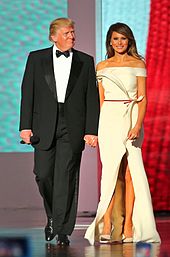 Trump and his wife Melania at the Liberty Ball on Inauguration Day
Trump and his wife Melania at the Liberty Ball on Inauguration Day
In 2005, Trump married his third wife, Slovenian model Melania Knauss, at Bethesda-by-the-Sea Episcopal Church in Palm Beach, Florida. The ceremony was followed by a reception at Trump’s Mar-a-Lago estate.[42] In 2006, Melania became a United States citizen[43] and gave birth to a son, Barron.[44][45] Melania became First Lady upon Trump’s inauguration as president in January 2017.[46]
Upon his inauguration as president, Trump delegated the management of his real estate business to his two adult sons, Eric and Don Jr.[47] His daughter Ivanka resigned from The Trump Organization and moved to Washington, D.C. with her husband Jared Kushner. She serves as an assistant to the president,[48] and he is a Senior Advisor in the White House.[49]
Religion
Trump’s ancestors were Lutheran on his father’s side in Germany[50] and Presbyterian on his mother’s side in Scotland.[51] His parents married in a Manhattan Presbyterian church in 1936.[52] As a child, he attended the First Presbyterian Church in Jamaica, Queens, and had his Confirmation there.[35] In the 1970s, his family joined the Marble Collegiate Church (an affiliate of the Reformed Church in America) in Manhattan.[53] The pastor at that church, Norman Vincent Peale ministered to Trump’s family and mentored him until Peale’s death in 1993.[54][53] Trump, who is Presbyterian,[55][56] has cited Peale and his works during interviews when asked about the role of religion in his personal life.[53]
Trump says he receives Holy Communion, but that he does not ask God for forgiveness.[57] While campaigning, Trump referred to The Art of the Deal as his second favorite book after the Bible, saying, „Nothing beats the Bible.“[58] The New York Times reported that evangelical Christians nationwide thought „that his heart was in the right place, that his intentions for the country were pure“.[59]
Trump has had associations with a number of Christian spiritual leaders, including Florida pastor Paula White, who has been called his „closest spiritual confidant“.[60] In 2015, he received a blessing from Greek Orthodox priest and hedge-fund manager Emmanuel Lemelson[61][62][63] and released a list of religious advisers, including James Dobson, Jerry Falwell Jr., Ralph Reed, and others.[64][65] Referring to his daughter Ivanka’s conversion to Judaism before her marriage to Kushner, Trump said: „… I have a Jewish daughter and I am very honored by that.“[66]
Health
Trump does not drink alcohol;[67] this decision arose in part from watching his older brother Fred Jr. suffer from alcoholism that contributed to his early death in 1981.[68][69] He also said that he has never smoked cigarettes or consumed drugs, including marijuana.[70]
In December 2015, Trump’s personal physician, Harold Bornstein, released a superlative-laden letter of health praising Trump for „extraordinary physical strength and stamina“.[71] Bornstein later said that Trump himself had dictated the contents.[72] A followup medical report showed Trump’s blood pressure, liver and thyroid functions to be in normal ranges, and that he takes a statin.[73][74] In January 2018, Trump was examined by White House physician Ronny Jackson, who stated that he was in excellent health, although his weight and cholesterol level were higher than recommended,[67] and that his cardiac assessment revealed no medical issues.[75] Several outside cardiologists commented that Trump’s weight, lifestyle and LDL cholesterol ought to have raised serious concerns about his cardiac health.[76]
Wealth
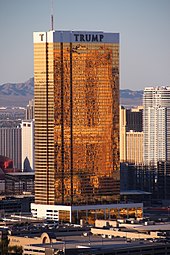 Trump International Hotel Las Vegas, with gold-infused glass[77]
Trump International Hotel Las Vegas, with gold-infused glass[77]
Trump is the beneficiary of several trust funds set up by his father beginning in 1949; Trump’s paternal grandmother also set up a trust fund for him in 1949.[78] In 1976, Fred Trump set up trust funds of $1 million for each of his five children and three grandchildren; Donald Trump received annual payments from his trust fund, for example $90,000 in 1980 and $214,605 in 1981.[78] By 1993, when Trump took two loans totaling $30 million from his siblings, their anticipated shares of Fred’s fortune was $35 million each.[79][78] Upon Fred Trump’s death in 1999, his will divided $20 million after taxes among his surviving children.[78][80][81]
Trump said that he began his career with „a small loan of one million dollars“ from his father, but did not acknowledge his father’s role in backing a $70 million loan during the construction of the Grand Hyatt hotel at the same time.[78][82] He appeared on the initial Forbes 400 list of richest Americans in 1982 with an estimated $200 million fortune shared with his father.[83] An ex-Forbes reporter said in 2018 that Trump had inflated his actual wealth in order to be included on the list.[84][85] Trump made the Forbes World’s Billionaires list for the first time in 1989,[86] but he was dropped from the Forbes 400 from 1990 to 1995 following business losses.[83] In 2005, Deutsche Bank loan documents pegged Trump’s net worth at $788 million, while Forbes quoted $2.6 billion and journalist Tim O’Brien gave a range of $150 to $250 million.[86] In its 2018 billionaires ranking, Forbes estimated Trump’s net worth at $3.1 billion (766th in the world, 248th in the U.S.)[87] making him one of the richest politicians in American history.
When he filed mandatory financial disclosure forms with the Federal Elections Commission (FEC) in July 2015, Trump claimed a net worth of about $10 billion;[88] however FEC figures cannot corroborate this estimate because they only show each of his largest buildings as being worth „over $50 million“, yielding total assets worth more than $1.4 billion and debt over $265 million.[89] Trump reported a yearly income of $362 million for 2014,[88] and $611 million from January 2015 to May 2016.[90]
Business career
Main article:Business career of Donald Trump
Real estate
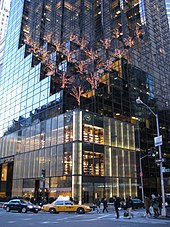 The distinctive façade of Trump Tower, the headquarters of The Trump Organization, inMidtown Manhattan
The distinctive façade of Trump Tower, the headquarters of The Trump Organization, inMidtown Manhattan
In 1968, Trump began his career at his father’s real estate development company, Elizabeth Trump & Son, which, among other interests, owned middle-class rental housing in New York City’s outer boroughs.[91][92] Trump worked for his father Fred, to revitalize the Swifton Village apartment complex in Cincinnati, Ohio, which the elder Trump had bought in 1964.[93][94] The management of the property was sued for racial discrimination in 1969; the suit „was quietly settled at Fred Trump’s direction.“[94] The Trumps sold the property in 1972, with vacancy on the rise.[94]
When his father became chairman of the board in 1971, Trump was promoted to president of the company and renamed it The Trump Organization.[11][95] In 1973, he and his father drew wider attention when the Justice Department contended in a lawsuit that their company systematically discriminated against African Americans who wished to rent apartments. The Department alleged that the Trump Organization had screened out people based on race and not low income as the Trumps had stated. Under an agreement reached in 1975, the Trumps made no admission of wrongdoing and made the Urban League an intermediary for qualified minority applicants.[96][97] Trump’s attorney at the time was Roy Cohn, who valued both positive and negative publicity, and responded to attacks with forceful counterattacks; Trump later emulated Cohn’s style.[98]
Manhattan developments
In 1978, Trump launched his Manhattan real estate business by purchasing a 50% stake in the derelict Commodore Hotel, located next to Grand Central Terminal. The purchase was funded largely by a $70 million construction loan that was guaranteed jointly by Fred Trump and the Hyatt hotel chain.[78][99] When the remodeling was finished, the hotel reopened in 1980 as the Grand Hyatt Hotel.[100]
Also in 1978, Trump obtained the rights to develop Trump Tower, a 58-story, 202-meter (663-foot) skyscraper in Midtown Manhattan, which Bill Geist in a New York Times cover story attributed to his „persistence“, his „skills as a negotiator“, and to „his finesse with the zoning code.“[101][102] To make way for the new building, a crew of undocumented Polish workers demolished the historic Bonwit Teller store, including art deco features that had initially been marked for preservation.[103] The building was completed in 1983 and houses both the primary penthouse condominium residence of Trump and the headquarters of The Trump Organization.[104][105] Architectural critic Paul Goldberger said in 1983 that he was surprised to find the tower’s atrium was „the most pleasant interior public space to be completed in New York in some years“.[106][107]
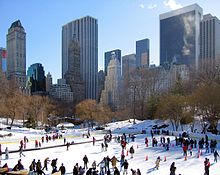 Central Park‘sWollman Rinkafter the Trump renovation
Central Park‘sWollman Rinkafter the Trump renovation
In 1980, repairs began on Central Park‘s Wollman Rink, with an anticipated two-and-a-half year construction time frame. Because of flaws in the design and numerous problems during construction, the project remained unfinished by May 1986 and was estimated to require another 18 months and $2 to $3 million to complete.[108][109] Trump was awarded a contract as general contractor in June 1986 to finish the repairs by December 15 with a cost ceiling of $3 million, with the actual costs to be reimbursed by the city.[108] Trump hired an architect, a construction company, and a Canadian ice-rink manufacturer and completed the work in four months, $775,000 under budget.[108] He operated the rink for a year and gave most of the profits to charity and public works projects[110] in exchange for the rink’s concession rights.[109] Trump managed the rink from 1987 to 1995. He received another contract in 2001 which was extended until 2021.[111][112] According to journalist Joyce Purnick, Trump’s „Wollman success was also the stuff of a carefully crafted, self promotional legend.“[111] While the work was in progress, Trump called numerous press conferences, for example for the completion of the laying of the pipes and the pouring of the cement.[113] In 1987, he also unsuccessfully tried to get the city to rename the landmark after him; the Trump logo is prominently displayed on the railing encircling the rink, on the ice resurfacer machine, colloquially referred to as a Zamboni,[111] on the rental skates,[112] and on the rink’s website.[112][114]
In 1988 Trump acquired the Plaza Hotel in Manhattan for a record-setting $407 million and appointed his wife Ivana to manage its operation.[115] Trump invested $50 million to restore the building, which he called „the Mona Lisa“.[116] According to hotel expert Thomas McConnell, the Trumps boosted it from a three-star to a four-star ranking. They sold it in 1995, by which time Ivana was no longer involved in the hotel’s day-to-day operations.[117]
In 1994, Trump got involved with the refurbishing of the Gulf and Western Building on Columbus Circle. The former office building was remodeled with design and structural enhancements to become a luxury residential and hotel property.[118][119] When the job was finished, Trump owned commercial space in a 44-story mixed-use tower (hotel and condominium) that he named Trump International Hotel and Tower.[120]
In 1996, Trump acquired the Bank of Manhattan Trust Building, which was a vacant seventy-one story skyscraper on Wall Street that had briefly been the tallest building in the world when it was completed in 1930. After an extensive renovation, the high-rise was renamed the Trump Building at 40 Wall Street.[121] In 1997, he began construction on Riverside South, which he dubbed Trump Place, a multi-building development along the Hudson River. He and the other investors in the project ultimately sold their interest for $1.8 billion in 2005 in what was then the biggest residential sale in the history of New York City.[122] From 1994 to 2002, Trump owned a 50% share of the Empire State Building. He would have renamed it „Trump Empire State Building Tower Apartments“ if he had been able to boost his share.[123][124] In 2001, Trump completed Trump World Tower. For a couple of years, the structure was the tallest all-residential tower in the world.[125] In 2002, Trump acquired the former Hotel Delmonico, which was renovated and reopened in 2004 as the Trump Park Avenue; the building consisted of 35 stories of luxury condominiums.[126]


